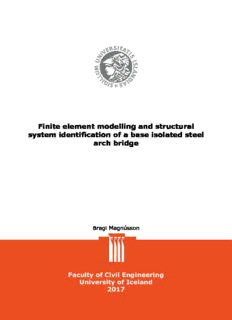Table Of ContentFinite element modelling and structural
system identification of a base isolated steel
arch bridge
Bragi Magnússon
Faculty of Civil Engineering
University of Iceland
2017
Finite element modelling and structural
system identification of a base isolated
steel arch bridge
Bragi Magnússon
30 ECTS thesis submitted in partial fulfillment of a
Magister Scientiarum degree in Civil Engineering
Advisor(s)
Rajesh Rupakhety
Bjarni Bessason
Simon Olafsson
Faculty Representative
Guðmundur Valur Guðmundsson
Faculty of Civil Engineering
School of Engineering and Natural Sciences
University of Iceland
Reykjavik, January 2017
Finite element modelling and structural system identification of a base isolated steel arch
bridge
30 ECTS thesis submitted in partial fulfilment of a Magister Scientiarum degree in Civil
Engineering
Copyright © 2016 Bragi Magnússon
All rights reserved
Faculty of Civil Engineering
School of Engineering and Natural Sciences
University of Iceland
Hjarðarhagi 6
107, Reykjavik
Iceland
Telephone: 525 4000
Bibliographic information: Magnússon B (2017) Finite element modelling and structural
system identification of a base isolated steel arch bridge, MSc thesis, Faculty of Civil and
Environmental Engineering, University of Iceland
Printing: Háskólaprent
Reykjavik, Iceland, January 2017
Abstract
With structures getting old and structural parameters changing with time, the ability to
monitor their changes gets very useful. This thesis focusses on system identification and its
ability to identify modal parameters. System identification is used to create mathematical
models of structures which are then compared to a finite element model. After the
comparison, the solution could be used to update the FEM as the structure changes. In the
thesis, different system identification methods are introduced and their theoretical
background is studied. Starting with identifying a simple SDOF system all the methods
introduced are applied and compared. After comparing the different methods one of them is
selected to be used in a case study where a modal identification is done on a base isolated
steel arch bridge. A finite element model is created on the bridge and compered to the
findings of the identification process. The results indicate the efficiency of system
identification in the sense that the identified modal parameters are very similar to those
obtained from the FEM of the structure created on the basis of structural drawings and
specifications.
Útdráttur
Ýmsir eiginleikar mannvirkja breytast með aldri þess. Með því að fylgjast með þessum
breytingum má greina ýmsar gagnlegar upplýsingar um ástand og heilsu burðarvirkis. Þessi
ritgerð fjallar um kerfisauðkenningu (e. system identification) sem gengur út á að búa til
stærðfræðilíkan af burðarkerfi og ákvarða sveifluhætti þess. Niðurstöðurnar má nota til
samanburðar og kvörðun á reiknilíkönum, sem til dæmis byggja á einingaaðferðinni. Í
ritgerðinni eru skoðaður fræðilegur bakgrunnur þriggja aðferða sem mikið eru notaðar við
kerfisauðkenningu. Einnar frelsisgráðu kerfi er notað til að bera þær saman. Bestu aðferðinni
er í framhaldinu beitt á raunverulegt mannvirki sem er stálbogabrú sem er
jarðskjálftaeinangruð með blý-gúmmílegum. Einnig er búið til einingarlíkan af brúnni þar
sem byggt er á upprunalegum burðarþolsteikningum og niðurstöður sem það líkan gefur
bornar saman við sveifluhætti sem fundnir eru með kerfisauðkenningunni. Góð samsvörun
fæst á milli sveiflueiginleika sem einingaraðferðin skilar af sér og stikana sem koma út úr
kerfisauðkenningunni.
Table of Contents
List of Figures ............................................................................................................ ix
List of Tables .............................................................................................................. xi
1 Introduction ............................................................................................................ 1
1.1 Problem statement .......................................................................................... 1
1.2 Aims and objectives ....................................................................................... 2
1.3 Research methodology ................................................................................... 2
1.4 Organization of the thesis ............................................................................... 3
2 Background and basic theory ............................................................................... 5
2.1 Structural dynamics ........................................................................................ 5
2.1.1 Basics equations in structural dynamics ........................................................ 5
2.2 System identification ...................................................................................... 6
2.3 Structural health monitoring ........................................................................... 7
3 Models ..................................................................................................................... 9
3.1 FE-model ........................................................................................................ 9
3.2 Spectral analysis for SI ................................................................................. 10
3.3 Parametric Methods ...................................................................................... 12
3.3.1 AR and ARX ................................................................................................ 13
3.3.2 ARMA and ARMAX ................................................................................... 14
3.3.3 Estimating model and system parameters .................................................... 14
3.4 State space models........................................................................................ 17
3.5 SDOF example ............................................................................................. 18
3.5.1 Spectral analysis........................................................................................... 19
3.5.2 Parametric method ....................................................................................... 21
3.5.3 State space methods ..................................................................................... 22
3.5.4 Conclusion ................................................................................................... 23
4 The case study bridge: Þjórsárbrú ..................................................................... 25
4.1 General description....................................................................................... 25
4.1.1 Measurements before upgrading the bridge ................................................. 26
4.1.2 Base Isolation of the bridge ......................................................................... 26
5 Finite Element model of the bridge. ................................................................... 29
5.1 Modeling Base Isolators ............................................................................... 29
5.2 Modal properties of the FEM model ............................................................ 30
5.3 System identification of the FEM model ..................................................... 33
5.3.1 Time series ................................................................................................... 33
5.3.2 Experimental design of monitoring system ................................................. 38
6 System identification ............................................................................................ 47
vii
6.1 Model order .................................................................................................. 47
6.2 Result of System identification .................................................................... 50
6.3 Comparison of results .................................................................................. 50
7 Conclusion and Discussions ................................................................................ 51
7.1 Further research ............................................................................................ 52
Bibliography ............................................................................................................. 55
Appendix A Calculations of LRB ........................................................................... 57
Appendix B Matlab code for SDOF example ........................................................ 59
Appendix C Code for experimental design and main calculations ...................... 63
Appendix D Mode shaped from FEM .................................................................... 66
viii
Description:parameters of dynamic system by using input and output data cracking of concrete, yielding and corrosion of steel reinforcement, and Structural systems can be complex, and their behaviour can be described by Finite Element Model Updating of a 15-story Building using Earthquake & Ambient.

